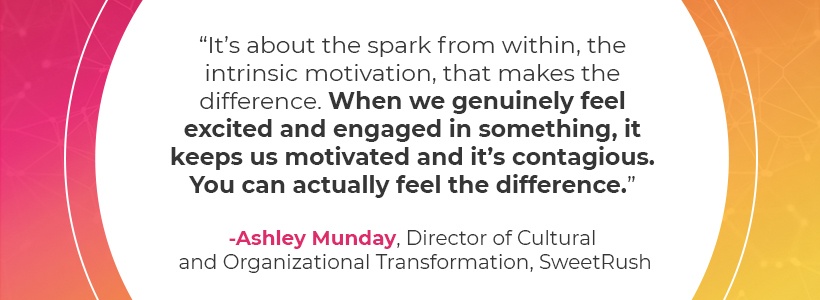10 Practices To Boost Your Organizational Culture
Two months after listening to a talk, the average listener will remember only about 25% of what was said. In fact, after we have learned something, we tend to forget from one-half to one-third of it within eight hours [1].
Ever heard of the "milk pitcher" form of learning? The idea is that we just open up people’s minds and pour the content in. If only it were that easy! It certainly would have made school a breeze.
I see many organizations use the same approach to culture change. They think if they get their origin story down, put their values on posters and wallet cards, and clearly define the behaviors that are needed that employees will fall in line and the culture will blossom. However, "culture change requires a movement, not a mandate [2]." Think back to a time when a parent or a spouse lectured you on something. How quickly did you change that behavior? I’m sure they were clear about the behavior they expected, but it’s not just about the external direction. It’s about the spark from within, the intrinsic motivation, that makes the difference. When we genuinely feel excited and engaged in something, it keeps us motivated and it’s contagious. You can actually feel the difference.
Our heart rates change and our collective moods lift. This isn’t magic. It’s about consistent and applied approaches that create the conditions for cultural transformation. We need to engage people through the physical, emotional, mental, and transcendent ways of being.

Culture change is not just about the words. It’s about all the ways you show up and engage people. Here are some suggestions for true ENGAGEMENT:
Enjoy
Find your own enjoyment in living the desired culture. Fun, after all, is unique to each of us. I, for one, like to read dictionaries and compare word definitions. That certainly doesn’t hit everyone’s pleasure centers. There are so many ways to nurture the culture. Find yours and repeat it. If you’re having fun, you will draw people into it.
Network
Create a social network map that includes people you intentionally and regularly connect with. It should include people who are above you in the organization or field, peers, rising talent, clients, and thought leaders. Stay connected. Share what you’re learning and listen to them.
Get feedback
Engagement is not a one-way street. The root of the word "engage" means "to bind." Binding, bonding, and cohesion form through mutual understanding and commitment. If you want team members to be engaged, get their feedback, make changes based on their feedback, and communicate your wins.
Artifacts
Artifacts—the physical representation of beliefs and symbols—ground and remind people of what’s important to them. Think about sports team banners and T-shirts. They are artifacts. As a company, health care provider DaVita does this incredibly well. If you ever get the chance, I encourage you to visit their corporate headquarters in Denver. They have a philosophy of "All for One and One for All," and play on the Three Muskateers theme through all sorts of artifacts. They create traditions and rituals that bring these values to life. They have interactive walls that "community members"—what they call their employees—contribute to. Bring your culture to life through symbols and artwork that engages people's hearts and minds.
Grateful
Regularly focusing on what you’re grateful for contributes to a more mutually beneficial, prosocial culture [3]. Our gratitude makes us healthier physically and mentally. What if you created a regular gratitude reflection on your team? Notice what happens.
Explicit culture plans
If everyone is responsible, no one is responsible. There’s a concept called "social loafing [4]" that has found we are less likely to take action in a big group than if we are on our own. When a senior executive describes in detail her vision for an engaging culture, we already know that half of it is forgotten almost immediately. On top of that, we tend to think that someone else is taking care of it. It’s part of our "group think." I suspect there’s some genetically adaptive reason for this, but given that it seems to be our modus operandi, we need to work against it by explicitly identifying how we will shift our culture. That includes doing some sort of measurement to establish a baseline, defining your current and desired states, identifying milestones and tasks to get there, and assigning responsibility for someone to keep it moving forward. Once you create your culture plan, don’t try to boil the ocean. Pick 3 to 5 key areas to focus on, with 3 to 5 actions for each. Communicate and repeat. Have I said "repeat" lately? Repeat. And again. Sometimes when we’re working on culture change, we feel like a broken record. That’s okay. People need to hear things between 3 and 21 times to remember it. The newer the information, the more they need to hear it.
Meaning
People are meaning-making systems. We love to fit things into boxes by saying "this is like this" or "this is not like that." When people make sense of something on their own terms, with their own associations, it cements in their mind much deeper than just receiving information. Remember the milk pitcher model of learning? This is the opposite. It’s about allowing people to sift through the information, to question it, to relate it to what they know, and to explain what it means to them. Create spaces, meetings, and opportunities for your team members to process the culture you’re collectively striving to create. Let them make their own sense of it.
Endure
Rome was not built in a day, and nor was any culture sustainably changed in a month. Stay the course. Find your cheerleaders. Know who you can be vulnerable with and make time to grieve and celebrate the ups and downs of the culture journey. Transformation takes time.
New mindsets
Seeing is believing. People need to see the change to believe that it’s true. Many leaders speak a good game. They get enchanted by their own visions so that they don’t see the current reality. Shifting mindsets starts with leaders owning the change and taking responsibility for the beliefs employees have. If your employees believe that the company is focused only on the bottom line and doesn’t really care about them as human beings, they’re not likely to shift their mindsets. Identify current mindsets and the mindsets you desire for your team members. Work together with other leaders in your organization to take responsibility for (1) why the employees may be holding on to old mindsets and (2) what you and they can do to shift that belief system. How can they show team members that the new culture is real?
Trust
All strong relationships come down to trust. It’s about walking your talk, being competent, and showing others that you care. It goes beyond talk. Doing 360-degree assessments and working with a coach are great ways to keep you honest. Developing a feedback culture is also a great way to grow, given that the team members have a sense of empathy and genuinely desire the best for their colleagues and company.
The foundation of trust, though, is your trust with yourself. Do you believe in this organization? Do you believe this culture change is possible? Are you excited about it? Do you enjoy what you’re doing? If you focus on getting things right with yourself, you will be amazed at how that cascades to those around you.
Ultimately, organizational change begins with the inner change of the leaders, and that means you. Take responsibility for your own happiness and watch what happens around you. Follow up on the 10 points above, endure, and live the change!
L&D leaders need innovative, high-performing teams to meet today’s challenges. You need a high-performing team of pros with abundant creativity and a drive to innovate. The solution? Culture change. Download the eBook Secrets Of Effective L&D Leaders: Innovation, Embracing Change, And Cultural Transformation and find out more.
References:
[2] Changing Company Culture Requires a Movement, Not a Mandate
[3] 7 Scientifically Proven Benefits Of Gratitude That Will Motivate You To Give Thanks Year-Round


